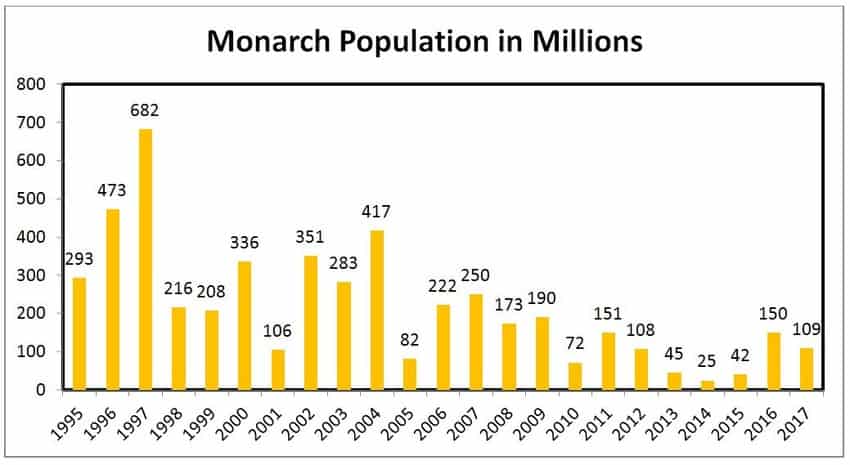Growing up in the Chicago suburbs in the 1980s and ’90s, Monarch butterflies were such a common sight during the summers. It wasn’t until I got older, got married, bought a house in the same Chicagoland area, and decided to put in a butterfly garden that I realized that the Monarch wasn’t as common as it once was. When I started researching butterfly garden designs and what plants attract butterflies, I kept coming across articles about the how much the Monarch population has declined and what plants are best for Monarchs. I was just looking for general information about butterfly gardens, but I kept getting search results about the Monarch. I think it was at that point that I started to question the last time I saw a Monarch.
Are Monarch butterflies going extinct? The sad truth is that the Monarch population in North America has declined significantly over the past 30 years. By some estimates, between 1990 and 2015, the number of Monarchs has decreased by as much as 90%. Other estimates show that between 1993 and 2016, their numbers were down 68%. To put some actual numbers with those percentages, in 2015 the Monarch population was estimated to be 42 million; in 2016 it was estimated at 150 million.
Did a big question mark just appear over your head? Do you have a confused look on your face? Yes, the Monarch population more than tripled between 2015 and 2016, but this does not mean that we are out of the woods. The Monarch’s decline has not been in a straight line. One year it might be low, the next year it might jump up only to fall again the following year. The 150 million estimate in 2016 is almost half of what it was in 2007, and almost 25% of what it was back in 1997 when the population was at 682 million.
I want to step back for a minute here and point out that the numbers above are for the eastern population of the North American Monarch. There are actually two separate populations of Monarchs in North America. The eastern population are the ones that migrate to Mexico for the winter. They are called “eastern” because they live and breed on the eastern side of the Rocky Mountains. There is also the western population that lives on the western side of the Rockies. Most of the articles written about the declining Monarch population use numbers and percentages that refer to the eastern population since this is the most prevalent population in North America. While the eastern population can still be saved, unfortunately, it looks like the western population is on the verge of extinction. Around Thanksgiving every year a group of volunteers works with the Xerces Society to count the western Monarchs overwintering in California. Their 2018 Thanksgiving count came in at the lowest level ever recorded: 28,429. That is 28 thousand, not million, and is an 85% drop from the 2017. It is believed that 30,000 is the threshold that needs to be maintained in order to avoid extinction. They are only slightly below that threshold so lets hope they can bounce back.
“Unfortunately, it looks like the western population is on the verge of extinction.”
Now that you’ve seen the dire numbers for the western population, the 150 million in the eastern population doesn’t seem so bad, does it? Although we might have had a little bounce over the last couple of years, if the overall trajectory continues its downward slope, it could be game over for our beloved Monarch. Let’s start by taking a look at the chart below, used with permission from the Center for Food Safety and the Center for Biological Diversity.

I like the above chart because it uses actual numbers of butterflies. If you do a Google search for “monarch population” and look at images, most of the charts show population in terms of how much area of forest is occupied by Monarchs overwintering in Mexico, measured in hectares. According to the Oxford dictionary, a hectare is a metric of square measure, equal to 100 ares (2.471 acres of 10,000 meters). I don’t know about you, but looking at the actual numbers of butterflies is easier to comprehend than hectares of forest occupied.
As we can see in the chart, the Monarch population fluctuates from year to year. So just because we might have had 3 years of of increasing population from 2014 to 2016, that doesn’t mean that it would be up again in 2017. Unfortunately, there was about a 27 percent drop in 2017. In 2018 there was an explosion in the population. They reported the highest number (in hectares) of Monarchs overwintering in Mexico since the winter of 2006/2007.
Why are the Monarchs in trouble? This can probably be answered in one word: humans. Monarchs need food to survive, just like you and I do. As caterpillars, they can only eat milkweed plants. As butterflies they drink nectar from flowers as their food source. As the human population continues to grow, we need to provide more shelter for those people. With every house, condo building, and apartment complex that is built, more and more milkweed is destroyed. Since Monarchs rely solely on milkweed to feed their baby caterpillars, without it, they can’t survive.
Then there is farming. More people means more food required to feed those people which in turn means we either need to expand farming or increase the yields that the farms produce. Land is expensive and farmers need every square inch of their farmland to produce the crops that eventually make it to our dinner tables. If there is milkweed growing in a farmer’s field do you think he or she is going to leave it there for the Monarchs or pull it out so they can plant crops, which is what they’re in business for? Technology has also introduced herbicide resistant crops so farmers can spray their fields with herbicides, killing milkweed and other unwanted vegetation without harming the crops. They also use pesticides on their crops to eradicate any bugs that might be feeding on their crops. Those pesticides aren’t selective so if there happens to be a Monarch caterpillar (or butterfly) that gets sprayed, it will die. Don’t get me wrong. I am not harping on farmers. They bust their asses to put food on our tables and I appreciate them for that. Farming is their business. They put food on their table by putting food on ours.
In addition to the increase food supply that is needed to support the increase in human population, there is also an increase in car and truck traffic, which leads to us needing more roads to get us from point A to point B in the least amount of time as possible. In his book “Monarchs and Milkweed: A Migrating Butterfly, a Poisonous Plant, and Their Remarkable Story of Coevolution“, Anurag Agrawal points out that “In the state of Illinois alone, perhaps 2 million monarchs are killed by cars during the southern migration each year.” Some have estimated that as much as 25 million Monarchs are killed each year by cars and trucks in the United States.
Deforestation is another threat to the Monarch. As I mentioned earlier, the Monarch spends the winter in the oyamel fir trees in Mexico. According to the World Wildlife Fund in their “FOREST DEGRADATION IN THE CORE ZONE OF THE MONARCH BUTTERFLY BIOSPHERE RESERVE 2015-2016” report, “between February 2015 and May 2016, 72.30 ha of forest were degraded in the core zone of the Monarch Reserve: 11.92 ha were affected by large scale illegal logging, 53.94 ha by wind-fallen trees, and 6.44 ha by drought. 73.3% of the illegal logging occurred in the State Property in Michoacan; while in San Felipe of Alzatí it decreased from 19.13 ha to 0.70 ha.” The Monarch Butterfly Biosphere Reserve protects 56,259 ha and its core area (13,551 ha) includes the forest habitat of the overwintering colonies of the monarch butterfly in Mexico.
Humans might be the main reason for the drastic decline in the Monarch population, but weather has also been a contributing factor. If you refer to the population chart above, look at the massive drop between 2000 and 2001. In the winter of 2001/2002 a storm hit central Mexico. In mid January of 2012, the forests where Monarchs migrate to was hit by a heavy rain followed by a sharp drop in temperatures. The Monarchs basically froze to death. Estimates range from 200 to 272 million Monarchs that were killed in this storm.
What can you do to help save the Monarch from extinction? The Monarch needs 3 things to avoid extinction: milkweed, nectar, and the Mexican forests. Milkweed is the host plant for the Monarch caterpillar. Monarch butterflies need nectar to live and the forests in Mexico to survive the winter. With more and more land being taken away for housing and farming, milkweed and native flowers are being taken away, too. Deforestation is taking away their overwintering sites. If you are looking for something that you as an individual can do to help save the Monarch, it would be to plant some milkweed. If you live in a house and have a garden, see if there is a spot that you can incorporate milkweed. If you live in an apartment or condo with a balcony that gets plenty of sun, you can plant milkweed in pots. I have also noticed that more and more cities and villages have been putting in butterfly gardens with milkweed plants for the Monarchs. If your town doesn’t have one, talk with your public works and see if they have any plans to put one in. They might be headed for extinction, but we still have time to save them.
